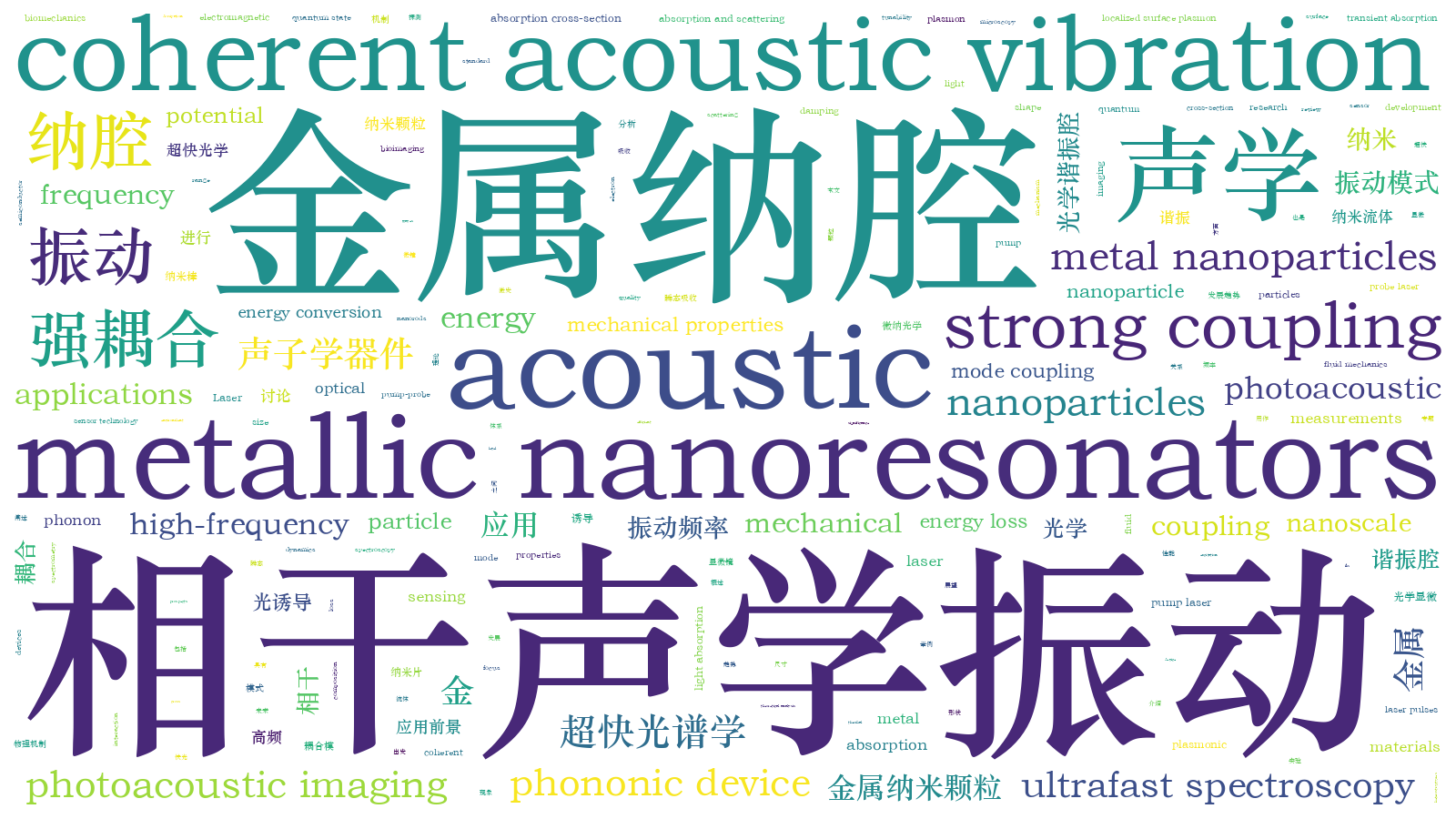光诱导金属纳腔的相干声学振动及应用  下载: 1716次特邀综述
下载: 1716次特邀综述
Metal nanoparticles exhibit superior optical resonances, known as localized surface plasmon resonances, due to collective oscillations of free electrons during their interaction with incident light. These resonances enhance light absorption and scattering, making these nanoparticles highly efficient in interacting with electromagnetic waves. The tunability of plasmon resonances through nanoparticle size, shape, and composition further enhances their optical responses. As a result, plasmonic nanoparticles are valuable for applications such as sensing, imaging, and energy conversion.
In addition to their optical resonances, metal nanoparticles also serve as acoustic resonators, capable of converting electromagnetic energy to mechanical energy through photoacoustic and optoacoustic effects. Excitation of metal nanoparticles by short laser pulses leads to rapid increases in electron and lattice temperatures, which generates thermal expansions and particle vibrations. The mechanical vibrations in metallic nanoresonators are influenced by factors such as nanoparticle size, shape, and surrounding environment. Accurate measurements of the acoustic vibrations provide insights into the mechanical properties of nanoresonators and the surroundings, with potential applications in nano-optomechanical devices, sensor technology, and photoacoustic imaging.
The vibrational frequencies of metallic nanoresonators typically range from a few to hundreds of GHz. Ultrafast pump-probe spectroscopy has emerged as a powerful tool for investigating these high-frequency mechanical vibrations. Due to the large absorption cross-section of plasmonic nanoparticles, it is feasible to study the acoustic vibrations in metallic nanoresonators at a single-particle level. In such experiments, a pump laser excites mechanical vibrations in single particles, and a delayed probe laser monitors the dynamics of the vibrations with high temporal resolutions. The ability to perform single-particle studies of acoustic vibrations provides new opportunities for understanding the vibrational energy damping mechanisms and mode coupling effects.
A significant issue related to metallic nanoresonators is energy loss, where the acoustic energy dissipates through both intrinsic and extrinsic damping pathways. Extending the vibrational lifetimes of acoustic nanoresonators is beneficial for nanomechanical spectrometry and sensing, vibrational coupling, and quantum state preparations. Many experimental studies primarily focus on the energy dissipation mechanisms in nanoresonators. Mass sensing, high-frequency biomechanics and bioimaging, and nanofluid mechanics are at the forefront applications of acoustic resonators with large vibrational quality factors.
While metal nanoparticles have been extensively studied, exploring other materials platforms, such as 2D semiconductor materials and heterostructures, offers new avenues for studying and harnessing acoustic vibrations at the nanoscale. These materials possess unique mechanical and acoustic properties that can be tailored and engineered to present great opportunities for nanoscale acoustic research and device development.
We review the coherent acoustic vibrations of metallic nanoresonators and discuss their potential applications. First, we discuss the excitation mechanism of coherent acoustic vibrations in metallic nanoresonators, and the corresponding transient absorption microscopy measurements. Second, the acoustic vibrational modes and frequencies of several metallic nanoresonators (including nanospheres, nanorods, and nanoplates), and the correlations with particle sizes and shapes are described (Figs. 3-5). Then we give detailed discussions on vibrational strong coupling between metallic nanoresonators, from experimental measurements of various vibrational coupling systems to theoretical analysis of the coupling mechanisms and mode profiles (Figs. 6-9). Further investigations of strong phonon coupling between acoustic nanoresonators are essential for quantum phonon manipulations in plasmonics. Next, we provide a few examples of the potential applications of high-frequency acoustic nanoresonators, with special emphasis on nanofluidics (Fig. 10). The studies demonstrate that the standard continuum fluid mechanics assumptions are no longer applicable at the nanoscale, and viscoelastic effects and interfacial slip phenomena must be considered. The observed nanoscale fluid phenomena have broad significance for the description and understanding of nanofluidics. Finally, the discussions on future development and applications of high-frequency acoustic nanoresonators are presented.
The study of acoustic vibrations in nanoresonators provides significant insights into the fundamental physics of nanoscale systems and opens up broad prospects for various applications, such as high-frequency biomechanics, nanofluid mechanics, and phonon frequency combs. Continuous research in this field has great potential for further discoveries and technological advancements.
余快, 陈云高, 汪国平. 光诱导金属纳腔的相干声学振动及应用[J]. 光学学报, 2023, 43(16): 1623015. Kuai Yu, Yungao Chen, Guoping Wang. Laser Excitation of Coherent Acoustic Vibrations of Metallic Nanoresonators and Their Applications[J]. Acta Optica Sinica, 2023, 43(16): 1623015.







